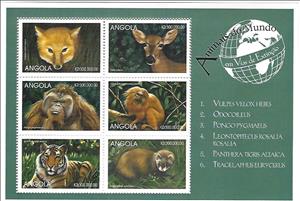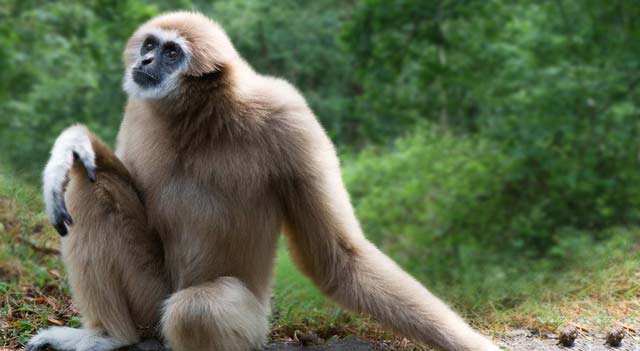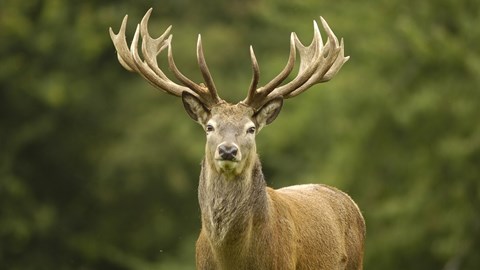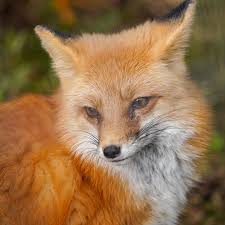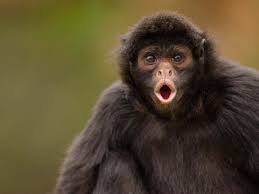Mini Sheet: Animals of the World in the Process of Extinction (Angola 1999)
Animals of the World in the Process of Extinction (Angola 1999)
25 March (Angola ) within release Animals of the World in the Process of Extinction goes into circulation Mini Sheet Animals of the World in the Process of Extinction face value 6*300000 Angolan kwanza
| Mini Sheet Animals of the World in the Process of Extinction in catalogues | |
|---|---|
| Michel: | Mi: AO 1335-1340KB |
| Stamp Number: | Sn: AO 1063 |
Mini Sheet is horizontal format.
Also in the issue Animals of the World in the Process of Extinction:
- Mini Sheet - Animals of the World in the Process of Extinction face value 6*300000;
- Stamp - Tremarctos ornatus face value 300,000;
- Stamp - Lepidochelys kempii face value 300,000;
- Stamp - Odocoileus virginianus face value 300,000;
- Souvenir Sheet - Ursus arctos horribilis face value 1,000,000;
- Stamp - Equus caballus przewalski face value 300,000;
- Mini Sheet - Animals of the World in the Process of Extinction face value 6*300000;
- Stamp - Panthera tigris altaica face value 300,000;
- Stamp - Pongo pygmaeus face value 300,000;
- Stamp - Ailuropada melanoleuca face value 1,000,000;
- Stamp - Leontopithecus rosalia rosalia face value 300,000;
- Stamp - Otus insularis face value 300,000;
- Stamp - Vulpes velox hebes face value 300,000;
- Souvenir Sheet - Ailuropada melanoleuca face value 1,000,000;
- Stamp - Aphelocoma face value 300,000;
- Stamp - Ursus arctos horribilis face value 1,000,000;
- Stamp - Mustela putorius face value 300,000;
- Stamp - Lutra canadensis face value 300,000;
- Stamp - Balaeniceps rex face value 300,000;
Mini Sheet Animals of the World in the Process of Extinction it reflects the thematic directions:
Animals are multicellular, eukaryotic organisms of the kingdom Animalia (also called Metazoa). All animals are motile, meaning they can move spontaneously and independently, at some point in their lives. Their body plan eventually becomes fixed as they develop, although some undergo a process of metamorphosis later on in their lives. All animals are heterotrophs: they must ingest other organisms or their products for sustenance.
Apes (collectively Hominoidea /hɒmɪˈnɔɪdi.ə/) are a clade of Old World simians native to sub-Saharan Africa and Southeast Asia (though they were more widespread in Africa, most of Asia, and Europe in prehistory), which together with its sister group Cercopithecidae form the catarrhine clade, cladistically making them monkeys. Apes do not have tails due to a mutation of the TBXT gene. In traditional and non-scientific use, the term ape can include tailless primates taxonomically considered Cercopithecidae (such as the Barbary ape and black ape), and is thus not equivalent to the scientific taxon Hominoidea. There are two extant branches of the superfamily Hominoidea: the gibbons, or lesser apes; and the hominids, or great apes.
The fishing cat (Prionailurus viverrinus) is a medium-sized wild cat of South and Southeast Asia. It has a deep yellowish-grey fur with black lines and spots. Adults have a head-to-body length of 57 to 78 cm (22 to 31 in), with a 20 to 30 cm (7.9 to 11.8 in) long tail. Males are larger than females weighing 8 to 17 kg (18 to 37 lb); females average 5 to 9 kg (11 to 20 lb). Since 2016, it is listed as Vulnerable on the IUCN Red List. Fishing cat populations are threatened by destruction of wetlands and have declined severely over the last decade. The fishing cat lives foremost in the vicinity of wetlands, along rivers, streams, oxbow lakes, in swamps, and mangroves.
A deer (pl.: deer) or true deer is a hoofed ruminant ungulate of the family Cervidae. It is divided into subfamilies Cervinae (which includes, among others, muntjac, elk (wapiti), red deer, and fallow deer) and Capreolinae (which includes, among others reindeer (caribou), white-tailed deer, roe deer, and moose). Male deer of almost all species (except the water deer), as well as female reindeer, grow and shed new antlers each year. These antlers are bony extensions of the skull and are often used for combat between males.
Foxes are small-to-medium-sized omnivorous mammals belonging to several genera of the family Canidae. They have a flattened skull; upright, triangular ears; a pointed, slightly upturned snout; and a long, bushy tail ("brush").
Mammals are any vertebrates within the class Mammalia (/məˈmeɪli.ə/ from Latin mamma "breast"), a clade of endothermic amniotes distinguished from reptiles (including birds) by the possession of a neocortex (a region of the brain), hair, three middle ear bones and mammary glands. All female mammals nurse their young with milk, secreted from the mammary glands. Mammals include the largest animals on the planet, the great whales. The basic body type is a terrestrial quadruped, but some mammals are adapted for life at sea, in the air, in trees, underground or on two legs. The largest group of mammals, the placentals, have a placenta, which enables the feeding of the fetus during gestation. Mammals range in size from the 30–40 mm (1.2–1.6 in) bumblebee bat to the 30-meter (98 ft) blue whale. With the exception of the five species of monotreme (egg-laying mammals), all modern mammals give birth to live young. Most mammals, including the six most species-rich orders, belong to the placental group. The largest orders are the rodents, bats and Soricomorpha (shrews and allies). The next three biggest orders, depending on the biological classification scheme used, are the Primates (apes and monkeys), the Cetartiodactyla (whales and even-toed ungulates), and the Carnivora (cats, dogs, seals, and allies).
Monkey is a common name that may refer to most mammals of the infraorder Simiiformes, also known as simians. Traditionally, all animals in the group now known as simians are counted as monkeys except the apes. Thus monkeys, in that sense, constitute an incomplete paraphyletic grouping; however, in the broader sense based on cladistics, apes (Hominoidea) are also included, making the terms monkeys and simians synonyms in regard to their scope.
The tiger (Panthera tigris) is a member of the genus Panthera and the largest living cat species native to Asia. It has a powerful, muscular body with a large head and paws, a long tail and orange fur with black, mostly vertical stripes. It is traditionally classified into nine recent subspecies, though some recognise only two subspecies, mainland Asian tigers and the island tigers of the Sunda Islands.
